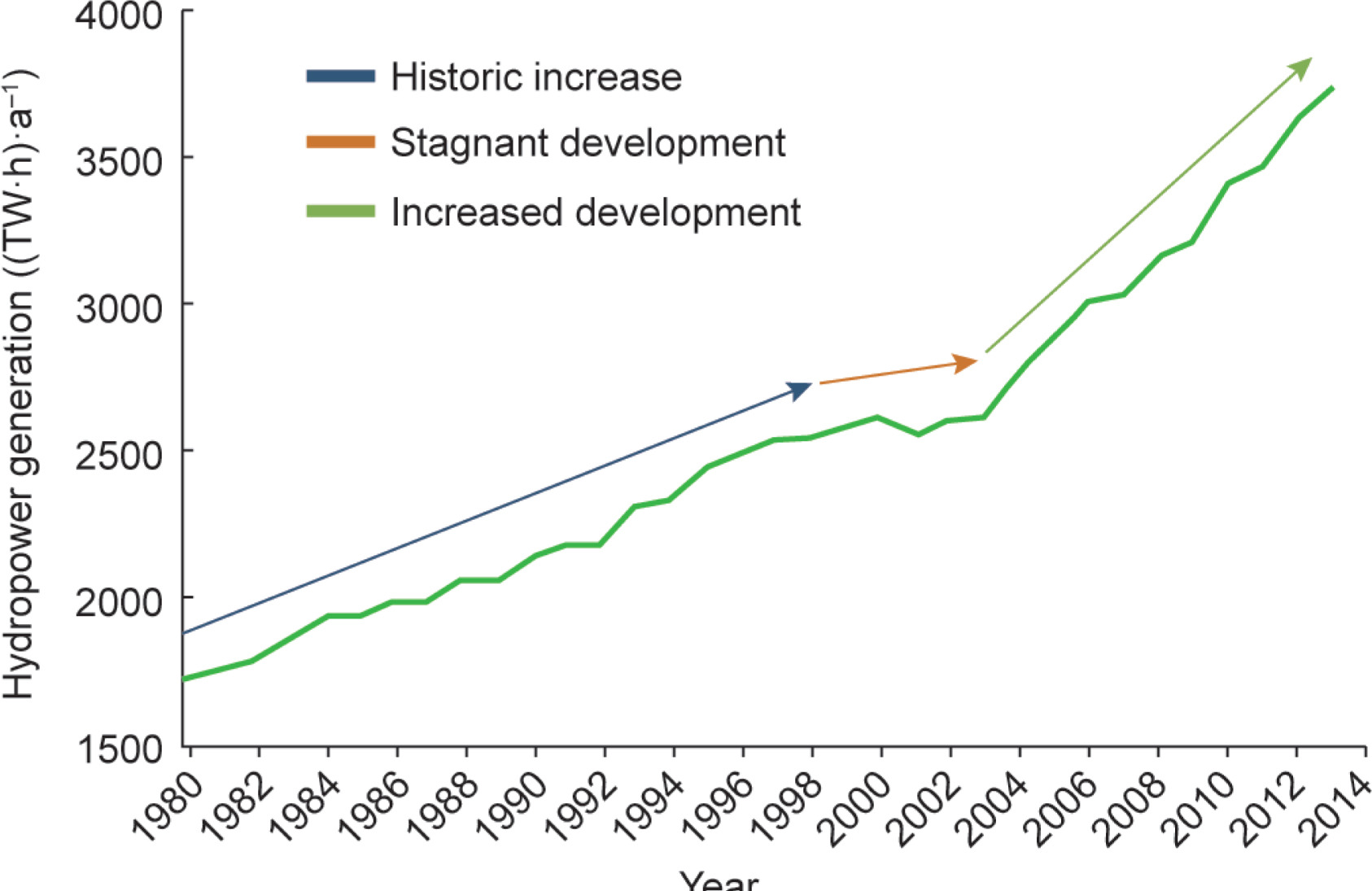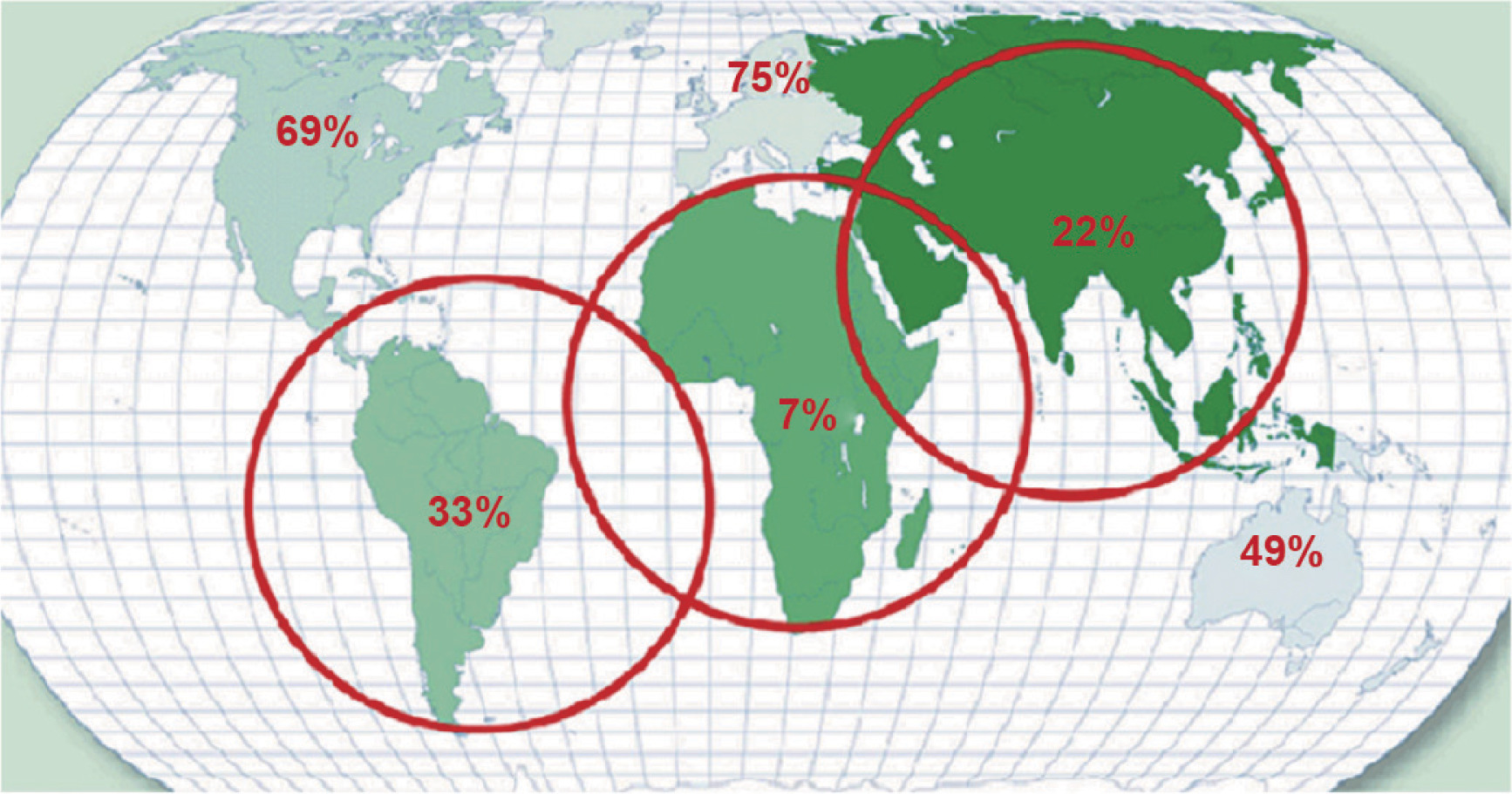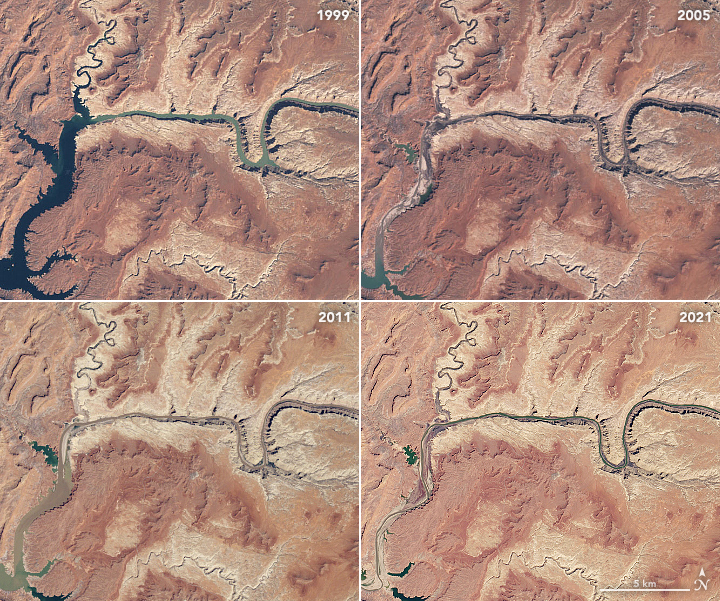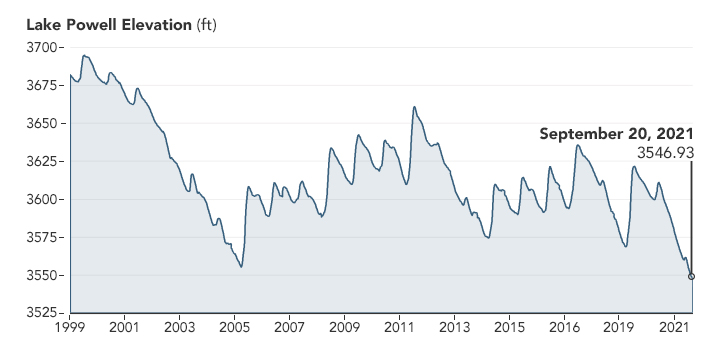May 10, 2022
Hydropower at the Glen Canyon Dam and Lake Powell: Challenges to Stay Efficient

Hydroelectric power is a common renewable energy source utilized by various countries and territories across the planet. As of 2018, hydroelectric power made up 17% of the world’s energy total electricity production and 78% of the world’s renewable electricity generation in 20151. While hydropower can fill a specific gap in electricity generation, one of the biggest issues impacting it is climate change. Climate change and hydropower are closely related to each other. Hydropower is a renewable energy source that assists in the avoidance of greenhouse gas emissions and mitigation of global warming. While hydropower is a great alternative to fossil fuel energy sources, changes to the hydrologic (water) cycle that result from climate change can largely impact its efficiency by reducing river discharge rate, lowering reservoir water levels, and reducing overall hydropower energy generation2.
Since 1980, hydropower electricity generation has grown significantly worldwide (Fig. 1) and is expected to continue growing. This is especially evident in developing countries where the technical hydropower potential—the portion of a resource that can be captured and converted into electricity using hydropower—is growing and still able to be utilized (Fig. 2)3,4. While hydropower is growing worldwide, climate issues such as changes in temperature and changes in precipitation are impacting hydropower generation and efficiency. Changes in precipitation can bring about decreased precipitation amounts, potentially increasing the frequency and magnitude of droughts, while leading to lower water levels for rivers or lakes. Precipitation, in the form of rain or snow, adds to the overall levels of these water bodies and increases the efficiency of the associated dam and the overall energy output. With changes to precipitation occurring more frequently, certain areas are less likely to experience consistent rainfall or snowfall and the water levels will begin to drop as usage increases5. Changes in temperature can also affect hydropower generation by causing increased evaporation of water, longer periods of drought, and increased levels of snowmelt. Increased evaporation of water means that water reservoirs, like lakes, that dams use for power generation will lose more water than in previous years. With the loss of water, the overall output of energy can decrease as reservoir water levels begin to fall. Similarly, longer periods of drought mean less rainfall in the area, less direct recharge of the water reservoirs, and a decrease in stream discharge. The same can be said about increased snowmelt. While an increase in snowmelt can bring about more recharge, less winter snow will be available to melt in the spring, ultimately leading to a decrease in recharge rates and streamflow (the amount of water flowing in a channel) for the river or reservoir6.


Developing countries like South America, Africa, and regions in Asia have only utilized 33%, 7%, and 22% of their hydropower potential respectively. When compared to developed areas that have utilized much more of their potential, these developing areas can still reliably meet their expanding energy needs with hydropower11.


In the past, arguments were made to remedy the increased evaporation rates of Lake Powell through a movement called “Fill Mead First”, which pushed for the water from Lake Powell to be released downstream into Lake Mead, essentially creating one reservoir with a smaller surface area than two separate ones. The goal of the movement was to reduce the overall evaporation rates observed in Lake Powell, and was sparked by research conducted following Glen Canyon’s construction in 196628. Although the idea of breaching Glen Canyon to fill Lake Mead gained significant traction, Jack Schmidt, a watershed scientist, and scientists from Utah State University were able to provide more updated data than what supported the Fill Mead First movement and identified that seepage–the leaking of water through porous material–was the main issue. Using newer methods of projections than those that sparked the Fill Mead First movement, scientists were able to discern that the amount of water lost was largely due to the age of the dam. Considering the initial research was conducted early in Glen Canyon’s life, the new research conducted almost 40 years later in 2016, found that since the desert surrounding the reservoir was not yet acclimated to the reservoir, more water was soaking into the ground than observed in 2016. While this proved that the Fill Mead First Movement would not solve water management problems, it opened up uncertainty about the state of Glen Canyon and Lake Powell, increasing the amount of research conducted on the two in subsequent years29.
While we certainly know more about Lake Powell and how to handle the ongoing issues faced there, climate change has always been the primary cause of problems at Glen Canyon Dam, in Lake Powell, and throughout the Upper Colorado River Basin. Changes in temperature and precipitation threaten the cycle of recharge and discharge that the basin has seen since the dam’s construction in the mid-1960s. Now, as increased evaporation, less snowmelt, and lower reservoir water levels threaten the power output of the Glen Canyon Dam, stricter measures to ensure Glen Canyon can adequately produce enough power to Upper Basin states have been taken. With ongoing climate issues, concerns about whether or not the dam will be able to provide enough power while also releasing enough water to supply the Lower River Basin dominate news headlines in the affected areas. Current projections state Glen Canyon is around 25% likely to hit its minimum power point within the next 5 years, and, with the effects of climate change ramping up every year, stricter means of water flow regulation and power usage are likely to be necessary to ensure the viability of the entire Colorado River System in the long term30.
- USGS U.S. Geological Survey, “Hydroelectric Power Water Use | U.S. Geological Survey,” Hydroelectric Power Water Use, June 8, 2018, https://www.usgs.gov/special-topics/water-science-school/science/hydroelectric-power-water-use. ↵
- Luis Berga, “The Role of Hydropower in Climate Change Mitigation and Adaptation: A Review,” Engineering 2, no. 3 (September 1, 2016): 313–18, https://doi.org/10.1016/J.ENG.2016.03.004. ↵
- Office of Energy Efficiency & Renewable Energy Department of Energy, “Hydropower Resource Assessment and Characterization,” Energy.gov, 2014, https://www.energy.gov/eere/water/hydropower-resource-assessment-and-characterization. ↵
- Luis Berga, “The Role of Hydropower in Climate Change Mitigation and Adaptation: A Review,” Engineering 2, no. 3 (September 1, 2016): 313–18, https://doi.org/10.1016/J.ENG.2016.03.004. ↵
- Blackshear B, Crocker T, Drucker E, Filoon J, Knelman J, Skiles M. 2011. Hydropower Vulnerability and Climate Change. :82. ↵
- Blackshear B, Crocker T, Drucker E, Filoon J, Knelman J, Skiles M. 2011. Hydropower Vulnerability and Climate Change. :82. ↵
- Luis Berga, “The Role of Hydropower in Climate Change Mitigation and Adaptation: A Review,” Engineering 2, no. 3 (September 1, 2016): 313–18, https://doi.org/10.1016/J.ENG.2016.03.004. ↵
- U.S. Federal Statistical System Energy Information Administration, “Where Hydropower Is Generated – U.S. Energy Information Administration (EIA),” March 16, 2022, https://www.eia.gov/energyexplained/hydropower/where-hydropower-is-generated.php. ↵
- Thiel, Aaron. “Climate Change Impacts on Hydropower in the Colorado River Basin.” Text Article. Center for Water Policy, October 6, 2014. https://uwm.edu/centerforwaterpolicy/wp-content/uploads/sites/170/2013/10/Colorado_Energy_Final.pdf. ↵
- USBR, United States Bureau of Reclamation. “Glen Canyon Dam | Upper Colorado Region | Bureau of Reclamation.” Glen Canyon Unit, August 19, 2021. https://www.usbr.gov/uc/rm/crsp/gc/index.html. ↵
- Luis Berga, “The Role of Hydropower in Climate Change Mitigation and Adaptation: A Review,” Engineering 2, no. 3 (September 1, 2016): 313–18, https://doi.org/10.1016/J.ENG.2016.03.004. ↵
- National Parks Service, Department of the Interior. “Climate Change – Glen Canyon National Recreation Area (U.S. National Park Service),” August 26, 2019. https://www.nps.gov/glca/learn/nature/climatechange.htm. ↵
- National Parks Service, Department of the Interior. “Climate Change – Glen Canyon National Recreation Area (U.S. National Park Service),” August 26, 2019. https://www.nps.gov/glca/learn/nature/climatechange.htm. ↵
- USBR, United States Bureau of Reclamation. “Glen Canyon Dam | Upper Colorado Region | Bureau of Reclamation.” Glen Canyon Unit, August 19, 2021. https://www.usbr.gov/uc/rm/crsp/gc/index.html. ↵
- McAfee, Stephanie A., Gregory T. Pederson, Connie A. Woodhouse, and Gregory J. McCabe. “Application of Synthetic Scenarios to Address Water Resource Concerns: A Management-Guided Case Study from the Upper Colorado River Basin.” Climate Services 8 (December 1, 2017): 26–35. https://doi.org/10.1016/j.cliser.2017.10.003. ↵
- Bates, Sofie. “Drought Makes Its Home on the Range.” Climate Change: Vital Signs of the Planet, September 27, 2021. https://climate.nasa.gov/news/3117/drought-makes-its-home-on-the-range. ↵
- USBR, United States Bureau of Reclamation. “Glen Canyon Dam | Upper Colorado Region | Bureau of Reclamation.” Glen Canyon Unit, August 19, 2021. https://www.usbr.gov/uc/rm/crsp/gc/index.html. ↵
- Carlowicz, Michael. “Lake Powell Reaches New Low.” Text.Article. NASA Earth Observatory, September 23, 2021. https://earthobservatory.nasa.gov/images/148861/lake-powell-reaches-new-low. ↵
- Carlowicz M. 2021 Sep 23. Lake Powell Reaches New Low. accessed 2022 Feb 14 https://earthobservatory.nasa.gov/images/148861/lake-powell-reaches-new-low. ↵
- Lee, Se-Yeun, Alan F. Hamlet, and Eric E. Grossman. “Impacts of Climate Change on Regulated Streamflow, Hydrologic Extremes, Hydropower Production, and Sediment Discharge in the Skagit River Basin.” Northwest Science 90, no. 1 (January 2016): 23–43. https://doi.org/10.3955/046.090.0104. ↵
- Kopytkovskiy, M., M. Geza, and J. E. McCray. “Climate-Change Impacts on Water Resources and Hydropower Potential in the Upper Colorado River Basin.” Journal of Hydrology: Regional Studies 3 (March 1, 2015): 473–93. https://doi.org/10.1016/j.ejrh.2015.02.014. ↵
- USBR, United States Bureau of Reclamation. “Newsroom | Bureau of Reclamation.” Newsroom, May 3, 2022. https://www.usbr.gov/newsroom/. ↵
- US Geological Survey, Water Science School. “Streamflow and the Water Cycle | U.S. Geological Survey,” June 12, 2019. https://www.usgs.gov/special-topics/water-science-school/science/streamflow-and-water-cycle. ↵
- Kopytkovskiy, M., M. Geza, and J. E. McCray. “Climate-Change Impacts on Water Resources and Hydropower Potential in the Upper Colorado River Basin.” Journal of Hydrology: Regional Studies 3 (March 1, 2015): 473–93. https://doi.org/10.1016/j.ejrh.2015.02.014. ↵
- Carlowicz, Michael. “Lake Powell Reaches New Low.” Text.Article. NASA Earth Observatory, September 23, 2021. https://earthobservatory.nasa.gov/images/148861/lake-powell-reaches-new-low. ↵
- USBR, United States Bureau of Reclamation. “Newsroom | Bureau of Reclamation.” Newsroom, May 3, 2022. https://www.usbr.gov/newsroom/. ↵
- USBR, United States Bureau of Reclamation. “Newsroom | Bureau of Reclamation.” Newsroom, May 3, 2022. https://www.usbr.gov/newsroom/. ↵
- Langlois, Krista. “Busting the Big One.” High Country News. September 4, 2017. ↵
- Langlois, Krista. “Busting the Big One.” High Country News. September 4, 2017. ↵
- USBR, United States Bureau of Reclamation. “5-Year Probabilistic Projections,” February 25, 2022. https://www.usbr.gov/lc/region/g4000/riverops/crss-5year-projections.html. ↵
Tags from the story
Climate change
Colorado River
Glen Canyon
Lake Powell
Water Management
Recent Comments
Ben Kruck
I find it smart that hydroelectric power is being used. I didn’t realize that the United States used a lot of hydroelectric power, and other countries surprised me as well for hydroelectric power, such as Australia and South America being as high as they are for hydroelectric power. I guess there is still a lot for me learn about the world.
25/08/2022
7:20 pm
Gabriella Parra
Hydroelectric power is an amazing source of renewable energy. It makes complete sense to use the natural resources you have, and the benefits of using it are great. It’s sad that a big threat to this source of renewable energy is climate change which is largely caused due to the use of unrenewable energy sources. Very insightful article! I’m glad you wrote on this topic.
18/09/2022
7:20 pm
Courtney Mcclellan
This article really made me think about if it is too late to help the planet. We have switched to renewable energy but because of past grievances and green house gas emissions, the environment is changing and causing our renewable resources to be obsolete. It is really smart to try using your renewable resources while you can but unless we stop damaging the earth entirely, it may be too late to even find another renewable resource that will stick around.
21/09/2022
7:20 pm
Ryan Romine
I think it is super smart to use water to generate power. The water is going to be there so we might as well use it to generate power. I knew we used this type of energy, however I did not know how much we used hydroelectric power in the United States. On the other hand, I think we need to find a way to not have the side effects of hydroelectric power. The water we are using is suffering from this type of generation and we need to find a way to limit the damage we do creating power.
22/08/2022
7:20 pm